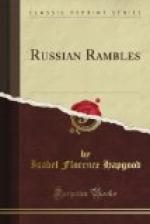I was driving down the Nevsky Prospekt on the afternoon of New Year’s Day, 1889, when, just at the gate of the Anitchkoff Palace, a policeman raised his hand, and my sledge and the whole line behind me halted. I looked round to see the reason, and beheld the Emperor and Empress sitting beside me in the semi-state cream-colored carriage, painted with a big coat of arms, its black hood studded with golden doubleheaded eagles, which the present Emperor used on his wedding day. A coachman, postilion, and footman constituted the sole “guard,” while the late prefect, General Gresser, in an open calash a quarter of a mile behind, constituted the “armed escort.” They were on the roadway next to the horse-car track, which is reserved for private equipages, and had to cross the lines of public sledges next to the sidewalk. On other occasions, such as launches of ironclad war vessels, the expected presence of the Emperor and Empress was announced in the newspapers. It was easy enough to calculate the route and the hour, if one wished to see them. I frequently made such calculations, in town and country, and, stranger though I was, I never made a mistake. When cabinet ministers or high functionaries of the Court died, the Emperor and Empress attended one of the services before the funeral, and the funeral. Thousands of people calculated the hour, and the best spot to see them with absolute accuracy. At one such funeral, just after rumors of a fresh “plot” had been rife, I saw the great crowd surge up with a cheer towards the Emperor’s carriage, though the Russians are very quiet in public. The police who were guarding the route of the procession stood still and smiled approvingly.
But sometimes the streets through which the Emperor Alexander III. was to pass were temporarily forbidden to the public; such as the annual mass and parade of the regiments of the Guards in their great riding-schools, and a few more. I know just how that device worked, because I put it to the proof twice, with amusing results.
The first time it was in this wise: There exists in St. Petersburg a Ladies’ Artistic Circle, which meets once a week all winter, to draw from models. Social standing as well as artistic talent is requisite in members of this society, to which two or three Grand Duchesses have belonged, or do belong. The product of their weekly work, added to gifts from each member, is exhibited, sold, and raffled for each spring, the proceeds being devoted to helping needy artists by purchasing for them canvas, paints, and so forth, to clothing and educating their children, or aiding them in a dozen different ways, such as paying house-rent, doctor’s bills, pensions, and so forth, to the amount of a great many thousand dollars every year. When I was in Petersburg, the exhibitions took place in the ballroom and drawing-room of one grand ducal palace, while the home and weekly meetings were in the palace of the Grand Duchess Ekaterina Mikhailovna, now dead. An amiable poet, Yakoff Petrovitch, invited me to attend one of these meetings,—a number of men being honorary members, though the women manage everything themselves,—but illness prevented my accompanying him on the evening appointed for our visit. He told me, therefore, to keep my invitation card. Three months elapsed before circumstances permitted me to use it.




